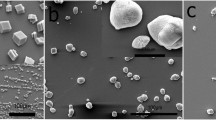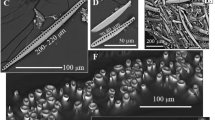Abstract
The mesoglea of alcyonarians is occupied by an abundance of minute calcitic sclerites. The sclerites of the alcyonarian Lobophytum crassum contain a water-soluble organic matrix comprising 0.48% of the sclerite weight and a water-insoluble fraction comprising 1.15% of the sclerite weight. Analysis of proteinaceous components in the soluble fraction shows a particularly high content of aspartic acid, followed by alanine, glycine, and glutamate. Aspartic acid, glycine, alanine, and glutamate are the most abundant residues in the insoluble fraction. In both cases, the fractions show the highest concentration of aspartic acid from the total proteins. In an in vitro assay, we show that the matrix proteins extracted from the calcitic sclerites induce the formation of amorphous calcium carbonate prior to its transformation into the calcitic crystalline form. We also show scanning electron micrographs of the rhombohedral calcite crystals used as template, the protein imprinted with these crystals. Sodium dodecyl sulfate-polyacrylamide gel electrophoresis of both matrices shows the protein fractions at 67 and 48 kDa. The soluble matrix shows two additional faint bands. Both fractions stain for a carbohydrate at 67 kDa, indicating a glycoprotein at this molecular weight. A newly derived protein sequence was subjected to bioinformatics analysis involving identification of similarities to other acidic proteins. The identification of these proteins in alcyonarian endoskeletal sclerites emphasizes the fundamental importance of such acidic proteins and sheds more light on the functions of these proteins in the processes of biocalcification.




Similar content being viewed by others
References
Kingsley RJ, Watabe N (1982) Ultrastructural investigation of spicule formation in the gorgonian Leptogorgia virgulata (Lamarck) (Coelenterata:Gorgonacea). Cell Tissue Res 223:325–334
Silver L, Boskey AL (2004) Diffusion systems for evaluation of biomineralization. Calcif Tissue Int 75:494–501
Watabe N (1981) Crystal growth of calcium carbonate in the invertebrates. Prog Crystal Growth Charact 4:99–147
Weiner S (1979) Aspartic acid-rich proteins: major components of the soluble organic matrix of mollusk shells. Calcif Tissue Int 29:163–167
Gotliv B-A, Addadi L, Weiner S (2003) Mollusk shell acidic proteins: in search of individual functions. ChemBioChem 4:522–529
Falini G, Weiner S, Addadi L (2003) Chitin-silk fibrin interactions: relevance to calcium formation in invertebrates. Calcif Tissue Int 72:548–554
Wilbur KM, Simkiss K (1968) Calcified shells. In: Florkin M, Stotz EH (eds), Comprehensive biochemistry, vol 26A. Elsevier, New York, pp 229–295
Lowenstam HA, Weiner S (1989) On biomineralization. Oxford University Press, New York
Mitterer RM (1978) Amino acid composition and metal binding capability of the skeletal protein of corals. Bull Mar Sci 28:173–180
Mitterer RM (1971) Comparative amino acid composition of calcified and non-calcified polychaete worm tubes. Comp Biochem Physiol B Biochem Mol Biol 38:405–409
Meenakshi VR, Hare PE, Watabe N, Wilbur KM (1969) The chemical composition of the periostracum of the molluscan shell. Comp Biochem Physiol 29:611–620
Rahman MA, Isa Y, Uehara T (2005) Proteins of calcified endoskeleton: II. Partial amino acid sequences of endoskeletal proteins and the characterization of proteinaceous organic matrix of spicules from the alcyonarian, Synularia polydactyla. Proteomics 5:885–893
Rahman MA, Isa Y (2005) Characterization of proteins from the matrix of spicules from the alcyonarian, Lobophytum crassum. J Exp Mar Biol Ecol 321:71–82
Young SD (1971) Organic material from scleractinian coral skeletons-I. Variation in composition between several species. Comp Biochem Physiol B Biochem Mol Biol 40:113–120
Silberberg MS, Ciereszko LS, Jacobson RA, Smith EC (1972) Evidence for a collagen-like protein within spicules of coelenterates. Comp Biochem Physiol B Biochem Mol Biol 43:323–332
Degens ET (1976) Molecular mechanisms on carbonate, phosphate, and silica deposition in the living cell. Top Curr Chem 76:1–112
Weiner S, Traub W, Lowenstam HA (1983) Organic matrix in calcified exoskeletons. In: Westbroek P, de Jong EW (eds) Biominerals and biological metal accumulation. Reidel, Dordrecht, pp 205–224
Linde A, Lussi A, Crenshaw MA (1989) Mineral induction by immobilized polyanionic proteins. Calcif Tissue Int 44:286–295
Laemmli UK (1970) Cleavage of structural proteins during assembly of the head of bacteriophage T4. Nature 227:680–685
Zacharius RM, Zell TE, Morrison JH, Woodlock JJ (1969) Glycoprotein staining following electrophoresis on acrylamide gels. Anal Biochem 30:148–152
Segrest JP, Jackson RL (1972) Molecular weight determination of glycoproteins by polyacrylamide gel electropheresis in sodium dodecyl sulfate. In: Ginsberg V, (ed), Methods in enzymology, vol 28. Academic Press, New York, pp 54–63
Crenshaw MA (1972) The soluble matrix from Mercenaria mercenaria shell. Biomin Res Rep 6:6–11
Krampitz GP (1982) Structure of the organic matrix in mollusk shells and avian eggshells. In: Nanocollas GH (ed), Biological mineralization and demineralization. Dahlem Konferenzen. Springer, Berlin, pp 219–232
Johnston I (1980) The ultrastructure of skeletongenesis in hermatypic corals. Int Rev Cytol 67:171–214
Meenakshi VR, Hare PE, Wilbur KM (1971) Amino acids of the organic matrix of neogastropod shells. Comp Biochem Physiol B Biochem Mol Biol 40:1037–1043
Kasai H, Ohta N (1981) Relationship between organic matrices and shell structures in recent bivalves. In: Habe T, Omori M (eds), Study of molluscan paleobiology. Prof. Masae Omori Memorial Volume Publication Committee, Niigata University, Niigata, pp 107–123
Weiner S, Lowenstam HA, Hood L (1977) Discrete molecular weight components of the organic matrices of mollusk shells. J Exp Mar Biol Ecol 30:45–51
DeJong EW, Bosch L, Westbroek P (1976) Isolation and characterization of a Ca2+-binding polysaccharide associated with coccoliths of Emiliania huxlei (Lohmann) Kamptner. Eur J Biochem 70:611–621
Tompa AS, Wilbur KM, Waite JH (1977) Structural proteins in the calcified egg shell of the giant land snail Strophocheilus oblongus (Becquaert). Comp Biochem Physiol B Biochem Mol Biol 56:279–283
Miyamoto H, Miyashita T, Okushima M, Nakano S, Morita T, Matsushiro A (1996) A carbonic anhydrase from the nacreous layer in oyster pearls. Proc Natl Acad Sci USA 93:9657–9660
Samata T, Sanguansri P, Cazaux C, Hamm M, Engels J, Krampitz G (1980) Biochemical studies on components of mollusk shells. In: Omori M, Watabe N (eds), The mechanisms of biomineralization in animals and plants. Tokai University Press, Tokyo, pp 37–48
Wilbur KM, Bernhardt AM (1982) Mineralization of molluscan shell: effects of free and polyamino acids on crystal growth rate in vitro. Am Zool 22:952
Belchar AM, Wu XH, Christensen RJ, Hansma PK, Stucky GD, Morse DE (1996) Control of crystal phase switching and orientation by soluble mollusk-shell proteins. Nature 381:56–58
Acknowledgments
This study was supported by a grant from the 21st Century COE project “The Comprehensive Analyses on Biodiversity in Coral Reef and Island Ecosystems in Asian and Pacific Regions” from the Ministry of Education, Culture, Sports, Science, and Technology of Japan (Monbukagakusho). The first author is grateful to the Rotary Yoneyama Memorial Foundation, Japan, for scholarship grants and especially to all the members of Ginowan Rotary Club, Okinawa, for their great help and cooperation during the period of the grants.
Author information
Authors and Affiliations
Corresponding author
Rights and permissions
About this article
Cite this article
Rahman, M.A., Isa, Y., Takemura, A. et al. Analysis of Proteinaceous Components of the Organic Matrix of Endoskeletal Sclerites from the Alcyonarian Lobophytum crassum. Calcif Tissue Int 78, 178–185 (2006). https://doi.org/10.1007/s00223-005-0253-y
Received:
Accepted:
Published:
Issue Date:
DOI: https://doi.org/10.1007/s00223-005-0253-y




